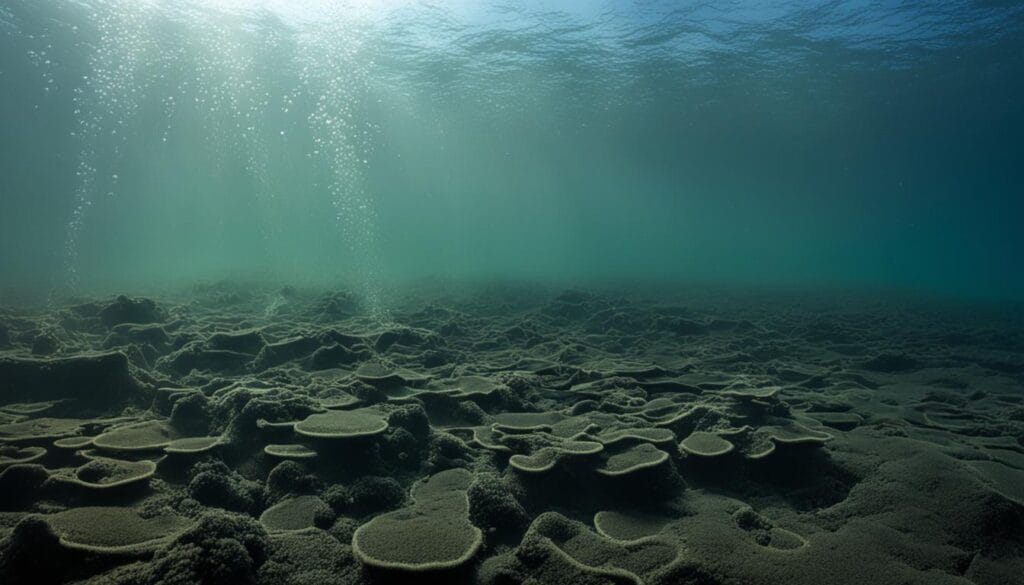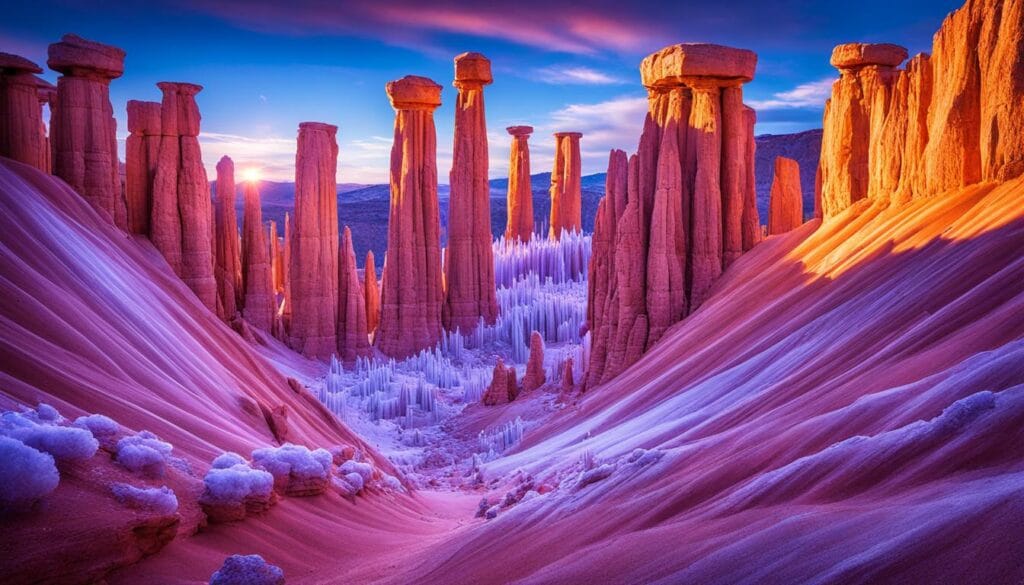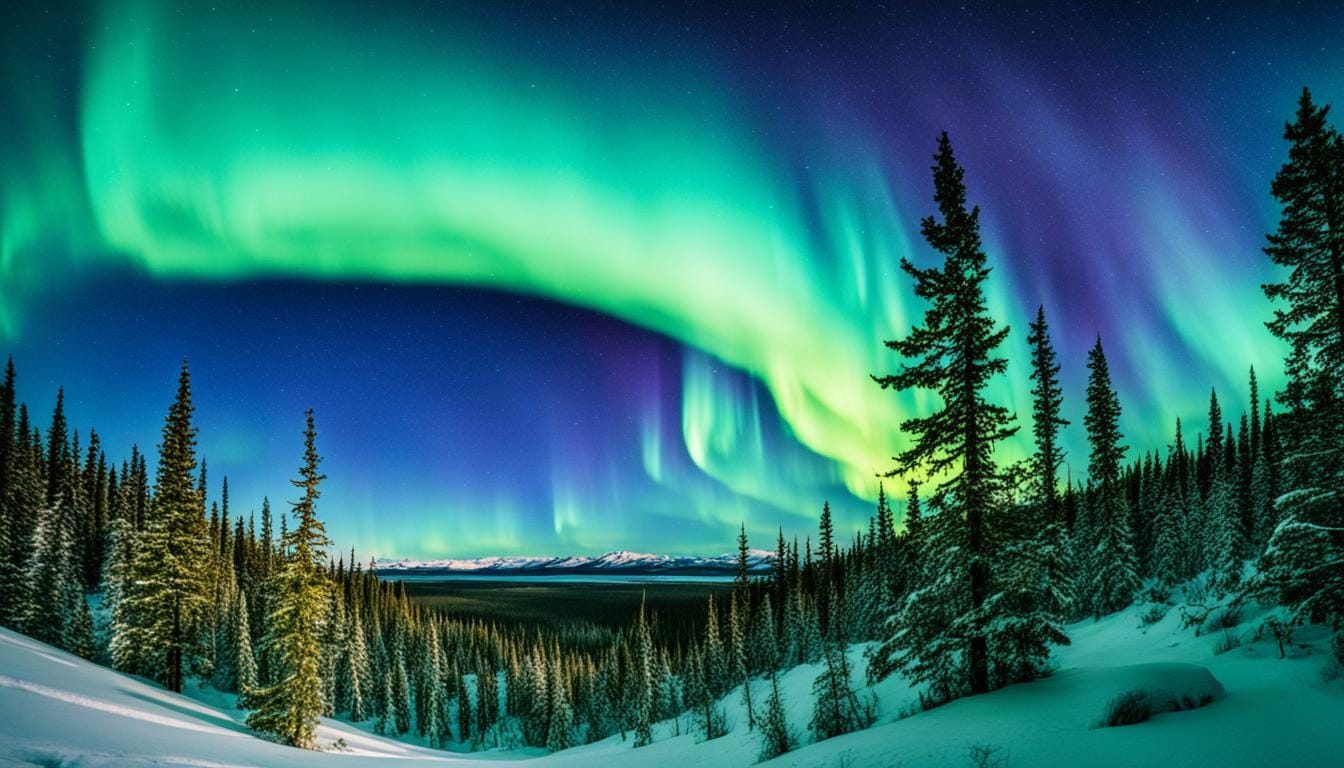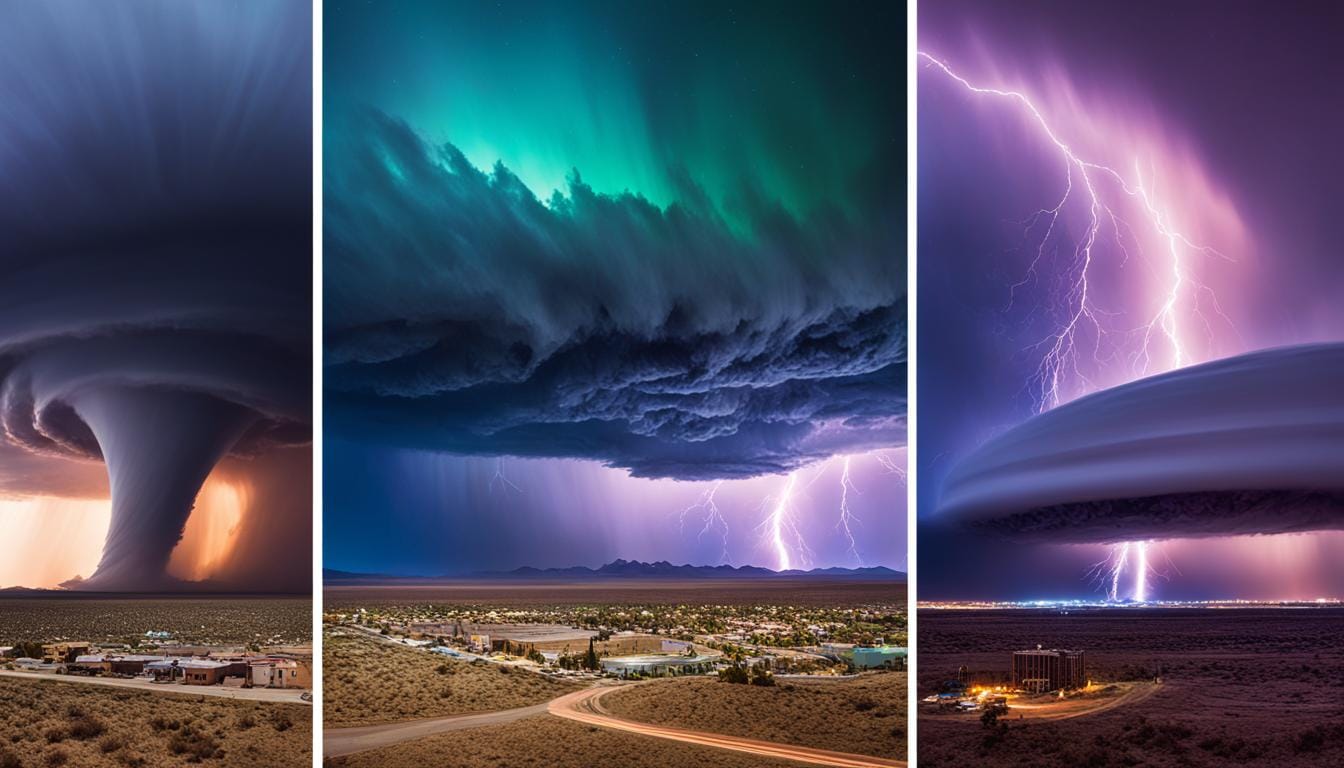Nature shows off its power and beauty with strange and baffling events. From glowing oceans to methane bubbles that might explode, these events amaze us. Here are five mind-boggling natural events that are hard to explain, including weird weather and mysterious earth happenings.
The biggest mega-tsunami ever was 120 feet tall and moved at 450 mph. The tallest water spout was as tall as half a mile. These events show the strange things our planet can do.
The 1986 eruption at Lake Nyos in Cameroon killed over 1,700 people and 3,500 animals. The 1815 eruption of Mount Tambora in Indonesia sent 160 cubic kilometers of material into the air. Nature’s power is both amazing and scary.
There are flammable ice bubbles in Siberia, big enough to fill over 3,000 party balloons. And there’s a huge underwater sinkhole in the Atlantic Ocean, known as the Bermuda Triangle.
Strange things happen in the sky, with animals and plants acting in ways we can’t understand. Let’s look at five of the most amazing and mysterious natural events. They will make you wonder about our planet’s secrets.
Marvel of Glittering Oceans
Have you ever seen the ocean glow in neon blue, green, or red? This is called bioluminescence, a light show from algae blooms in warm, calm waters. When waves or splashes disturb the sea, they start a chemical reaction that makes the water sparkle.
What Causes the Bioluminescent Glow?
The glow comes from a chemical reaction in plankton cells. It’s when a molecule called luciferin reacts with oxygen, making oxyluciferin and light. This isn’t just in the ocean; some sea creatures like squid and fish can glow too.
Where to Experience Bioluminescent Waters
- Sam Mun Tsai Beach in Hong Kong is famous for its glowing waters. The calm, clear waters are perfect for plankton to light up the sea.
- Bioluminescent events are happening more often worldwide, especially along the California coast from Baja to Los Angeles. This year’s glow is one of the brightest in over 20 years.
Diving or just watching, the ocean’s bioluminescent glow is a wonder that amazes everyone who sees it.

Tiny Bubbles of Lethal Explosives
Popping bubbles is fun, but not at Abraham Lake in Canada. These frozen bubbles are filled with methane, a highly flammable gas.
The methane comes from organic matter on the lake bed. When it tries to escape, the cold water freezes it into tiny, frozen bubbles. These methane bubbles are very inflammable and could explode if they get a spark.
Touching these bubbles is dangerous because they could release methane quickly. People visiting Abraham Lake should watch from a safe distance. They should not do anything that could make the bubbles pop.

The methane bubbles at Abraham Lake are amazing but also very dangerous. They remind us of nature’s power and unpredictability. Visitors must be careful and respect this unique place.
Bloody Lake That Never Freezes
If you’re not easily spooked, get ready to be amazed by the Bloodfalls in Antarctica’s Dry Valleys. This red water flows like a river, thanks to a hidden process under the surface.
The Bloodfalls get their red color from the brine iron in the lakes under the glaciers of the Dry Valleys. This salt-rich water doesn’t freeze, even in the freezing cold of Antarctica, the coldest glacier on Earth.
The water flows endlessly, moving through the subglacial lakes and cracks. This cycle of melting and freezing keeps the river going. Scientists have long been intrigued by this place, showing how life can thrive in extreme conditions.

The Science Behind the Bloodfalls
The Bloodfalls come from these scientific events:
- About two million years ago, a salty water body got trapped under the Taylor Glacier, away from light, oxygen, and heat.
- Over time, this water touched the rocks, dissolving minerals rich in iron. This made a salty, iron-rich brine.
- When the glacier melts, this brine comes out, creating the Bloodfalls that flow all year.
The brine iron and the Dry Valleys‘ extreme cold stop the Bloodfalls from freezing. This makes them one of the most unique and fascinating natural sights in the world.
A Crystal Shower of Light
The Northern Lights often get all the attention, but light pillars are another winter wonder worth seeing. These beams of light look like they’re falling from the sky. They happen in very cold places.
How Do Light Pillars Form?
Light pillars happen when light from things like streetlights or the moon hits ice crystals in the air. These tiny crystals move down, bending the light. This makes it look like vertical shafts of light are coming down. This is often seen in places like Raubichi, Belarus, where it’s very cold and perfect for light pillars.
To see this amazing sight, you need to be in the right spot at the right time. Look for clear, calm nights when it’s freezing. You’ll need light from the moon, stars, or streetlights for the ice crystals to work their magic. With everything just right, you can see light pillars that seem to come from the winter phenomena above.

Strange Natural Events
Nature is full of weird weather, unexplained events, and mysterious changes that amaze us. From glowing oceans to methane bubbles that might explode, these events are hard to explain. They challenge what we think we know.
In the Maldives and Jervis Bay, Australia, you can see a glowing sea. This comes from tiny creatures called Dinoflagellates. They make the water glow with a magical effect.
The Blood Falls in Antarctica have been flowing for over a million years. This red waterfall looks like blood. It happens because of an old lake under the ice, full of iron, that slowly comes out.
The Caño Cristales, or “Liquid Rainbow,” in Colombia, shows off bright colors. You can see yellow, green, blue, and red. This happens when certain plants bloom, making the river look amazing.
| Phenomenon | Location | Cause |
|---|---|---|
| Bioluminescent Shores | Maldives, Jervis Bay | Microorganisms called Dinoflagellates |
| Blood Falls | Antarctica | Ancient, iron-rich subglacial lake |
| Caño Cristales (Liquid Rainbow) | Colombia | Blooming algae and moss |
These are just a few examples of the strange things that happen in nature. From the Rainbow Mountains in China to the Blue Fire Volcano in Indonesia, our world is full of amazing sights. These wonders inspire and amaze us all.
Snowy Sculptures of Forgiveness
In the high-altitude Atacama Desert of Chile, a unique event happens every year. The penitentes, snow sculptures that look like kneeling figures, form. These snow blades can be up to 5 meters long and face the sun.
These snow sculptures are called “penitentes” in Spanish, meaning “remorseful.” The sun’s heat turns the snow into water vapor, a process called sublimation. This heat also creates spaces between the penitentes, making them look unique.
Penitentes aren’t just on Earth. They can also be found on Pluto and Europa, a moon of Jupiter. These distant penitentes help us learn about the surfaces of other planets and moons.
The Formation of Penitentes
Penitentes form from sunlight, wind, and temperature. The sun’s rays melt and vaporize the top snow layers, creating small depressions. These depressions grow deeper, making the snow around them more exposed to heat.
This process keeps happening, making the snow blades more defined. The wind shapes and aligns the penitentes with the wind direction. This creates a beautiful landscape of snow sculptures that seem to touch the sky.
Penitentes on Earth and other planets show how diverse and complex nature is. These snow sculptures inspire wonder and awe. They remind us to appreciate our planet and the universe’s beauty and strength.
Ethereal Northern Lights
The Aurora Borealis, or Northern Lights, is a stunning natural event seen in the far north. It happens when charged particles from the sun meet the Earth’s magnetic field. This creates a beautiful light show in the sky, with colors like green, purple, blue, and red.
The best time to see the Aurora Borealis is during winter, especially around the equinoxes. This is when the Earth tilts away from the sun, making the sky darker. Look for clear nights with no moonlight to see the lights better. Great places to watch include Denali National Park in Alaska and Voyageurs National Park in Minnesota.
The Aurora Borealis can be hard to predict because it depends on the sun and the Earth’s magnetic field. But if you’re patient and have a clear sky, you might see this amazing sight. It’s an experience you won’t forget.
- The Aurora Borealis is mostly seen in the Northern Hemisphere’s high-latitude regions.
- The best time to view the Northern Lights is usually from late September to early April.
- The colors of the Aurora Borealis come from charged particles from the sun interacting with gases in the Earth’s atmosphere.
- Solar activity that causes the Northern Lights happens about every 11 years, with the next peak expected in 2024-2025.
- Agencies like NASA and NOAA provide alerts to help predict when the Northern Lights will be most active.
Witnessing Nature’s Wonders
The natural world is full of amazing sights that amaze and intrigue us. From glowing oceans to methane bubbles that might burst, these natural phenomena make us wonder and ask questions. Our understanding of these mysteries is growing, but many still puzzle us, making us think and imagine what they could be.
In Canada’s Banff National Park, you can see thousands of white disks on the lake. These disks are frozen methane bubbles. In Antarctica, the Taylor Glacier has a red stream that looks like blood because of the iron in it. Death Valley National Park has a strange place called Racetrack Playa where rocks move on their own, leaving tracks behind.
Indonesia’s Kawah Ijen crater lake is like a neon dream, glowing blue because of sulfuric gases. In Australia, Pink Lake Hillier is pink because of salt and special tiny life forms. Namibia’s Namib Desert has Fairy Circles, round bare spots that scientists can’t fully explain, with theories about radioactive soil and termites.
These sights show us the amazing things in our world. As we learn more about them, we find new ways to explain them and discover more about our world’s secrets.
Star Jelly: A Cosmic Mystery
Rain, snow, sleet, and hail are common forms of precipitation. But, there’s a mysterious substance that falls from the sky, leaving scientists puzzled: star jelly. This gelatinous material is translucent and often found in grass or on trees. It evaporates quickly after being seen.
Many think star jelly might come from dying stars, alien waste, or government drones. But, its true source is still unknown. It doesn’t have any DNA from plants or animals, making it even more mysterious.
Star jelly is often mistaken for a cosmic substance but is actually frog or toad spawn. It grows bigger when it absorbs water from dew or rain. People have seen it in places like Scotland, Texas, and Britain. Some link it to meteor events.
Scientists study star jelly a lot because it shows up often. It’s linked to frogs or toads and comes from their ovum jelly. This jelly gets bigger when it gets wet. The first time star jelly was seen was in the 14th century. Since then, many reports have come in, like a glowing ball of goo in Lowville, New York, in 1846.
The origins of star jelly are still a mystery, fascinating scientists and fans. As we learn more about it, we keep trying to figure out where it comes from. The search for answers about this strange substance continues.
Morning Glory Clouds
Morning glory clouds look soft but are far from it. These tube-shaped clouds can stretch over 600 miles across the sky. They are mainly seen in Australia and have sparked the interest of many, including those in Aboriginal myths.
Exploring the Unexplained Formations
The morning glory clouds are a mystery in the sky. They can be as tall as 2 kilometers and move fast, 10-20 meters per second. These tube-shaped clouds often come with strong winds and sudden changes in wind direction. Despite lots of research, scientists still don’t fully understand how they form.
These clouds are usually seen when the weather changes from dry to wet in the Gulf of Carpentaria region of northeastern Australia. Researchers have tried to figure out why they look the way they do. They think it might be like waves moving through a stable layer of air. But, they haven’t been able to predict when these clouds will appear.
The Aboriginal people believe these clouds mean more birds will come soon. Scientists are still trying to understand these clouds better. But the morning glory clouds show us how much we still don’t know about nature.
Cities in the Sky
On April 21, 2017, in Jieyang, China, many people saw a city floating on the clouds. This was a Fata Morgana, a rare weather event. It happens when light goes through heat waves and creates a duplication effect. This makes it look like a city is floating in the sky.
Before this event, floating cities were seen at five places in China in just over six years. Some thought it might be aliens or a test hologram. But the most likely reason is the Fata Morgana effect. It’s when the sky duplicates the skyline below because of light refraction.
This natural trick of the eye can be amazing to see. It makes people think about the mysteries of nature. It’s a sight that leaves many wondering.
The floating cities show how amazing our world is and how complex it can be. By studying these strange sights, we might learn more about our world. It’s a chance to discover new secrets.
The Enigma of Tabby’s Star
Tabby’s Star, also known as KIC 8462852, is a mystery in space about 1,470 light-years from Earth. It’s a star that’s hard to see with the naked eye but can be spotted with a small telescope. This star has a red dwarf companion and is an F-type main-sequence star.
NASA’s Kepler space telescope noticed something odd about Tabby’s Star from 2009 to 2013. Its brightness changed a lot, sometimes dropping by up to 20 percent. This big change sparked many theories, including the idea of planets or even aliens affecting its light.
Citizen scientists helped figure out what was happening with Tabby’s Star. In 2011, they noticed strange dimming patterns in the Kepler data. Since then, scientists have been trying to understand why the star dims, looking at events like “Elsie,” “Celeste,” “Skara Brae,” and “Angkor” from 2016 to 2018.
The idea of aliens using the star for energy is now seen as unlikely. But, what’s causing the dimming is still a puzzle. A recent study used NASA’s Spitzer and Swift missions to find that dust around the star is to blame. But, where this dust comes from is still a mystery.
Now, the Kepler telescope can’t watch Tabby’s Star anymore. But, new telescopes might uncover more secrets. The ongoing interest in Tabby’s Star shows us how much we still don’t know about our galaxy. It’s a reminder of the universe’s vast mysteries.
| Key Facts About Tabby’s Star | Value |
|---|---|
| Distance from Earth | 1,470 light-years (450 parsecs) |
| Stellar Classification | F-type main-sequence star with a red dwarf companion |
| Apparent Magnitude | +11.7 |
| Observed Light Fluctuations | Up to 20% dips in brightness |
| Notable Dimming Events | “Elsie,” “Celeste,” “Skara Brae,” and “Angkor” |
| Cause of Dimming | Likely an uneven dust cloud moving around the star |
Tabby’s Star keeps fascinating scientists and the public alike. It’s a reminder of the mysteries in our universe. As we learn more, the search for what’s behind its strange behavior goes on.
Raining Animals: A Bizarre Phenomenon
Have you ever heard of raining animals? It sounds like something from a fantasy story, but it’s real. Flightless creatures have fallen from the sky in many places. Fish, frogs, spiders, and worms have all been known to rain down from above.
Experts think that waterspouts or tornadoes are behind this strange event. These storms can lift small animals from their homes and drop them somewhere else. But, we’ve never seen it happen, so we’re still trying to figure it out.
Another weird thing is when raw meat falls from the sky. In Kentucky back in 1876, people saw chunks of fresh meat coming down. They were left wondering where it came from.
| Location | Reported Raining Animals | Year |
|---|---|---|
| Texarkana, Texas | Fish | 2021 |
| Pilger, Nebraska | Tornadoes | 2014 |
| Santo Antônio da Platina, Brazil | Spiders | 2013 |
| Ishikawa Prefecture, Japan | Frogs and toads | 2009 |
| Jennings, Louisiana | Worms | 2007 |
We’re still trying to understand why these strange events happen. But they keep us curious and amazed. Whether it’s fish or raw meat, the sky can surprise us in amazing ways.
Blood-Red Skies: Apocalyptic Signs?
In April 2016, people in Chalchuapa, El Salvador, saw the sky turn a deep, blood-red color. This strange sight made many in the evangelical Christian community think it was a sign of the oncoming apocalypse. They believed it matched the predictions in the Book of Revelation.
Despite some theories, the reason for the blood-red sky is still unknown. Some think it might be linked to the April meteor showers. Others point to stubble fires from sugarcane farmers. But the sudden and brief nature of the event has left many wondering if it was a sign of the end.
Reports of apocalyptic signs have been common throughout history. Between 1550 and 1559, over 400 pamphlets were published in Europe. They talked about strange happenings like unusual weather, stones falling from the sky, and rains of blood. In the early 1520s, these stories were very popular.
The blood-red sky in Chalchuapa might have a simple explanation, but it has sparked a big conversation. It shows how people are always looking for signs and meaning in the world around us.
Conclusion
The world is full of amazing and mysterious events that capture our attention and spark our imagination. From glowing waters to rare sights like sprites and moonbows, these events show the power and surprise of our planet. Even though science helps us understand some of these mysteries, many still leave us guessing and dreaming.
Trying to figure out these natural wonders is important, but so is protecting the world they live in. By keeping our ecosystems healthy, we make sure future generations can see these incredible sights. This way, they can also be amazed by the mysteries of our world.
From the beautiful lights of the Northern Lights to the stunning clouds of morning glory, our world is full of mysteries and beauty. By keeping our sense of wonder alive, we can learn more about these strange events. And we can work towards a future where we live in peace with the amazing forces that shape our planet.


